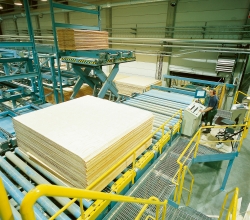Plywood and OSB in Construction
Introduction
Plywood is a widely used and well proven construction material made from a combination of wood veneers and resins. Oriented Strand Board (OSB) is an alternative to plywood in a variety of structural and non-structural applications. It is made from long strands of wood bonded together with a synthetic resin adhesive. Both products are available with full structural data and sustainable credentials.
Specifying Constructional Plywood
There are two types of Constructional Plywood:
Structural Plywood: Structural Plywood has proof of strength performance provided by the Supplier in addition to other product performance information
General Plywood: General Plywood has product performance information provided by the supplier but this will not include strength performance data and so should not be used in a structural application. Both types of constructional plywood can be used in the three end use classes for plywood defined in the European Standard EN 636 as shown in below. The standard specifies the requirements for plywood for general purposes or structural application in dry, humid or exterior conditions. Exterior Use РPermanently outside exposed to the weather:
Structural EN 636-3 S General EN 636-3 G
Humid Use – Most construction uses fall into this category as they are covered or rarely exposed to weather, but still at risk of wetting:
Structural EN 636-2 S
General EN 636-2 G
Dry Use – Interior with no risk of wetting:
Structural EN 636-1 S
General EN 636-1 G
The most common types of plywood available for use in UK construction are structural plywood for humid uses (EN 636-2S) and general plywood for humid uses (EN 636-2G). These types of plywood are made from durable resins which are suitable for most construction uses. Plywood for Exterior use is also available but may be less cost effective as both the resins and the wood veneers within the product must be durable in the long term. There is also a special type of exterior Plywood called Marine Plywood which has its own British standard BS 1088 2003, and as the name suggests must be durable enough to endure regular exposure to extreme weather conditions. However, Marine Plywood rarely has proof of strength performance provided by the supplier and so should not be used load bearing construction uses, unless this strength data is provided.
Specifying Constructional OSB
Constructional OSB comes in four grades (technical classes) as defined in the European Standard EN 300 and shown in the table below. The standard specifies the requirements for OSB for general purposes or structural applications in dry and humid conditions. Selection of a grade of load-bearing panel is dependent upon the ambient climatic conditions together with the level of loading that is anticipated. OSB 1 РGeneral purpose boards and boards for interior fitments (including furniture) for use in dry conditions. This should not be used in a structural application. OSB 2 – Load-bearing boards for use in dry conditions. OSB 3 – Load-bearing boards for use in humid conditions. OSB 4 – Heavy duty load-bearing boards for use in humid conditions. As with structural plywood, Structural OSB (OSB/2/3/4) has proof of strength performance provided by the supplier in addition to other product performance information. As with plywood, OSB that is used in construction must comply (by law) with the Construction Products Directive (CPD) and the recommended way to achieve this is by compliance with the Harmonised Standard for wood-based panels (EN13986); this standard calls up EN 300 for OSB. A CE logo may be present as an indication that the OSB meets the requirements of the European Standard EN 13986.
Construction Products Regulation
The construction industry is facing the most significant change for a decade in the way in which construction products are sold in Europe. From 1 July 2013, under the Construction Products Regulation (CPR), it will become mandatory for manufacturers to draw up a declaration of performance and apply CE marking to any of their construction products which is covered by a harmonised European standard for wood based panel products EN13986 when such a product is placed on the market. By definition a construction product is any product which is produced and placed on the market for incorporation in a permanent manner in construction works or parts thereof and the performance of which has an effect on the performance of the construction works with respect to the basic requirements for construction works. This is a major change as affixing of CE marking under the provisions of the existing Construction Products Directive (CPD) is currently voluntary in the UK. For those already CE marking under the CPD the transition should be straightforward. This publication is intended as a guide to the implications of CE marking under the CPR for manufacturers, importers, distributors, specifiers, certification and test bodies, and regulatory/enforcement authorities. The Regulation is directly applicable in UK law. The CPR builds upon the CPD and aims to break down technical barriers to trade in construction products within the European Economic Advice (EEA). To achieve this, the CPR provides for four main elements:
- a system of harmonised technical specifications
- an agreed system of conformity assessment for each product family
- a framework of notified bodies
- CE marking of products.
The CPR harmonises the methods of assessment and test, the means of declaration of product performance and the system of conformity assessment of construction products, but NOT national building regulations. The choice of required values for the particular intended use is left to the regulators and public / private sector procurers at the national level. However, such required values must be expressed in a consistent manner (technical language) as used in the harmonised technical specifications.




